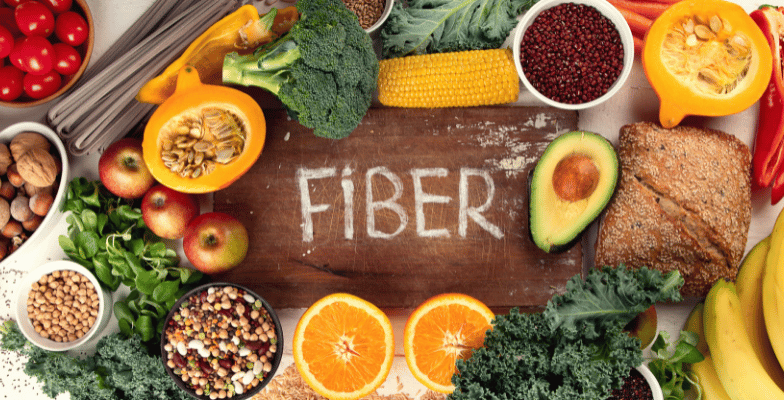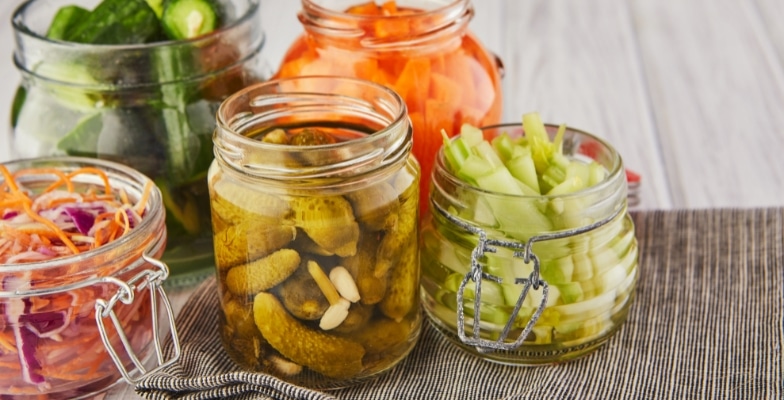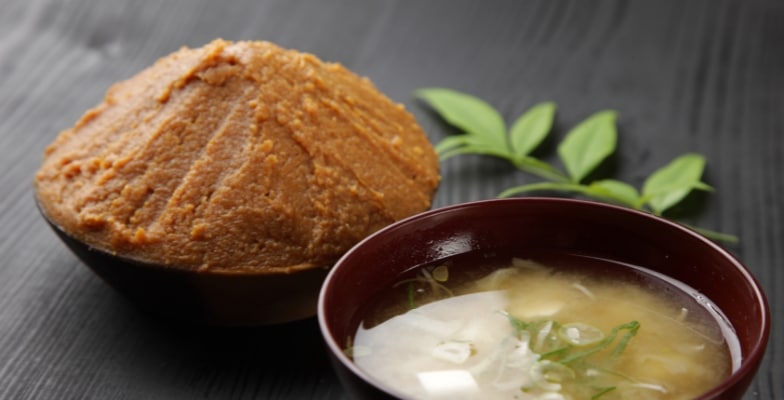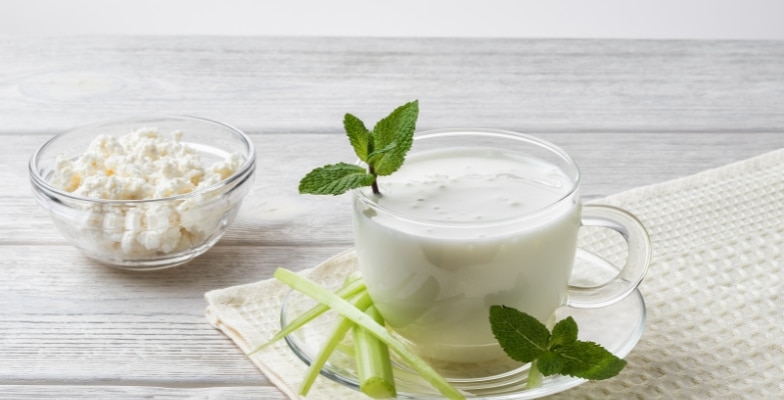What Is Fiber? Health Benefits, Food Sources And Daily Requirements
- Types Of Fiber
- Health Benefits Of Including Fiber In Your Diet
- How Much Fiber Do You Really Need?
- Foods High In Fiber
- 7 Tips On How Fulfil Your Daily Fiber Requirement
- Final Thoughts

Fiber is a type of carbohydrate that our body cannot digest or absorb.
It is referred to as bulk or roughage because our bodies cannot digest fiber. It passes through our stomach, small intestines, and colon and out of our bodies relatively intact. Fiber (also termed dietary fiber) can help you with regular bowel movements. It also assists with weight loss.
Studies have shown that optimal fiber intake can help lower heart disease, stroke, and diabetes. It may help with certain types of cancer, like colorectal cancer.
Types Of Fiber
Soluble Fiber
Soluble fiber can dissolve in water and forms a gel-like substance. Some examples of soluble fiber are gum, pectin and mucilage. Food sources rich in soluble fiber are peas, oats, apples, beans, carrots and barley. The main benefits of soluble fiber are that it helps to reduce blood glucose levels and blood cholesterol levels.
Another interesting fact about soluble fiber is that it is food to the beneficial bacteria that live in your gut. Did you know that bacteria in your large intestine outnumber human cells by 10:1? I discuss more good bacteria in my probiotic article (coming soon); for now, know this.
Most food we eat is digested and absorbed from the small intestine and hardly reaches the large intestine. This leaves very little for the bacteria in your gut to feed on.
However, soluble fiber passes through the small intestine relatively intact, making it a delicious snack for the good bacteria to feast on! This is the reason soluble fiber is also termed a prebiotic.
Insoluble Fiber
Insoluble fiber, as the name suggests, cannot dissolve in water. Examples include cellulose, lignin, and hemicellulose. Food sources rich in insoluble fiber are whole bran, whole-wheat like roti, potatoes and beans.
The main benefit of insoluble fiber is that it helps you keep regular by speeding up the passage of foods from the intestines. Let’s discuss the most important benefits of fiber (soluble and insoluble) in some detail.
Health Benefits Of Including Fiber In Your Diet
1) Helps You Stay Regular
As discussed, insoluble fiber helps add bulk to the stool, which makes it easier to pass, thus decreasing the chance of constipation. Constipation is one of the most common gastrointestinal issues that people experience around the world!
2) Helps You Lose Weight
The most important thing when it comes to weight loss is dealing with hunger and cravings. This is because in order to lose weight, it’s important to follow a calorie deficit diet.
When on a caloric deficit diet, almost everyone has to deal with cravings and hunger. A high-fiber diet is more filling as it helps stabilize your blood sugar levels which significantly reduces your cravings and hunger.
Another important aspect of a high-fiber diet is that almost every high-fiber foods are nutrient-dense, meaning they are high in vitamin minerals which further helps reduce cravings.
This is because cravings are simply a cry from your body to ingest more micronutrients that it needs to deal with billions of chemical reactions happening in your body at any given point in time.
3) Lowers Heart Disease Risk
High fiber intake is strongly linked to a reduction in heart disease. An umbrella review was conducted by Marc P. McRae, which was published in 2017. 1https://www.ncbi.nlm.nih.gov/pmc/articles/PMC5731843/
This umbrella review included all meta-analyses or systematic reviews. A total of 31 meta-analyses were included in this umbrella review, and all of these high-quality studies reported that eating a high-fiber diet results in a significant reduction in the relative risk of cardiovascular disease, stroke and coronary heart disease.
The clear reason was that fiber acts on low-density lipoprotein (bad cholesterol) and reduces it, thus lowering the risk of heart disease and other cardiovascular diseases.
4) Lowers Risk Of Certain Types Of Cancer
A study led by Maryam F. Farvid et al. led a large-scale study of women participants. It concluded that females who ate a high-fiber diet, especially during their adolescent years and early adulthood, reduced their breast cancer risk. 2https://pediatrics.aappublications.org/content/early/2016/01/28/peds.2015-1226
However, there is not enough evidence that supports that high fiber intake can lower the risk of colon cancer. 3https://pubmed.ncbi.nlm.nih.gov/9895396/
5) Lowers Risk Of Diabetes
Eating high-fiber foods such as oats, whole grains, and whole bran slows down the digestion process, which helps stabilize the sudden rise of blood glucose levels. This helps lower the risk of type-2 diabetes. Research also supports that a high-fiber diet lowers the risk of type-2 diabetes. 4https://pubmed.ncbi.nlm.nih.gov/12197996/, 5https://pubmed.ncbi.nlm.nih.gov/15277155/
How Much Fiber Do You Really Need?
Optimal Fiber intake is dependent on one’s age and gender. Check out the table below to find out your fiber intake.

Foods High In Fiber
It’s important to eat a variety of high-fiber foods to ensure that you get both types of fiber i.e. soluble and insoluble.
You don’t need to be particular about getting a fixed amount of a specific type of fiber as almost all fiber foods to contain varying amounts of fiber types in them. Just focus on including the following foods almost on a daily basis. This will ensure that you reach the optimal fiber intake according to your age and gender.
Fiber In Fruits
Fiber intake in most fruits is 2-3g for every 100 grams. Avocado is one fruit that is super high in fiber, providing 7g of fiber per 100g. Berries like blackberries and raspberries contain between 5-7g/100g. Pomegranate has 4g/100g.
Fiber In Vegetables
The fiber in most vegetables is also between 2-3g/100g. However, lima beans, peas, squash, and artichoke are loaded with fiber at 6g/100g!
Your regular veggies like broccoli, spinach, carrots, brussels sprouts, okra (bhindi), sweet potatoes, etc, contain between 2-3g/100g as mentioned above.
Fiber In Oats, Whole Grains, etc
Oats, barley, ragi, brown rice, and roti are all high-fiber foods.
Just make sure that you source the ingredients from a health store, as most commercially available grains and oats are highly processed, leaving very little fiber in them!

7 Tips On How Fulfil Your Daily Fiber Requirement
-Replace white bread, and rice with whole wheat bread and brown rice, respectively.
-Completely give up sugar-laden cereals and focus on only eating oats or quinoa.
-If you eat meat almost daily, start including lentils and beans in your diet a few times a week. This is because meats have zero fiber in them and lentils and beans have a lot in them!
-Include a variety of vegetables in both raw and cooked form.
-Completely avoid fruit juices, even freshly squeezed ones. This is when you juice a fruit; you are leaving all the fiber behind.
-Strive to get at least 5 servings of fruits and vegetables at any cost!
-Supplement your diet with psyllium husk if you are not able to fulfill your daily quote of fiber intake.
Final Thoughts
Fiber is super-important for us. Research clearly shows that a high-fiber diet can help you stay regular by preventing constipation. It makes losing weight easy. It also helps lower the risk of breast cancer and type-2 diabetes and significantly reduces the risk of cardiovascular diseases.
Unfortunately, most people’s diets are deficient in fiber intake, and their average is no more than 15g/day, which is very less than the recommended intake.
My suggestion is to gradually increase your fiber intake to give your gastrointestinal system time to adapt. At the same time, it’s also essential to increase your water intake when trying to increase fiber in your diet.
I strongly recommend that you include a variety of foods as listed above and follow the tips and suggestions provided to ensure that you are fulfilling your daily quote of fiber intake.
What do you think about this article? Have any questions? Let me know in the comments below!

Skill-Based Education.
Global Recognition.
Powerful Community Building
Secure a certificate of completion in as little as a day by graduating from one of our free courses.
Get Access to Our Free Courses. No Credit Card Required.

Fabulous Body Membership
Your All-Access Pass to A Fabulous Body & A Rewarding Career
25+ Certificate Courses & Programs, All Included
15 Day Free Trial, 100% Money-Back Guarantee
About Akash Sehrawat
Akash is a creator of 25+ programs and certificate courses in which more than 200,000 students have enrolled both on Udemy and Fabulous Body's native platform. Akash is also an author of three books that can be found on Amazon. His answers on Quora have gathered more than 12 million views in less than a year.











This article was so informative . Thanks Akash for sharing this.
Hi Akash,
Nice article.
Do you recommend fiber supplements?, If yes can you please name them.
Thanks,
RD
Hi Akash,
The above session is very impressive about Fibre.
From- Dr.D.K.Shrivastava
Newly entered Student for the Internationally accreditated Diploma in Sports Nutrition instructed by your supervision.
This was a real Good article and I enjoyed reading it. I can understand that providing technical information in simple words is not an easy task, myself being an author of a fitness Book in vernacular language. I am also a big fan of your fitness Business Course. Thank You for writing such a nice article.
Can I have your Mobile number?
Really a knowledge imparting article. So many people strive to count calories in their diet and focus on protein only. It is good to know there are so many other varients of food too those are much more important.
In North India we regularly include roti, potato and some fruits daily in our diet. Do you feel that this will make us fiber sufficient?
Thank you so much sir
Very useful and informative.
Sir i have a few question.
Q.What is the diet plan for weight loss and stamina gain?
It’s very useful article
Excellent article. I didn’t realize avocados were so high in fiber.
Loved it!! Very brief but definitely informative articleIt is also a good resource to check again later in time.
It’s good sir always learn something new from your article thanks
Thanks Manish:)
Thanks!
Yes! Avocados is truly a powerful and functional fruit:)
Thank you:)
Hey Priyanka, you follow a calorie deficit diet. The deficit should be no more than 30% less than TDEE. For stamina gain, workout! You can calculate your TDEE here: Free TDEE Calculator : How to Calculate TDEE
Hello Pankaj, You need to do some mental maths to ensure that you are getting more than 38 g of fiber per day. Its not an easy task. High quantities of dal and beans like rajma can truly help as they are very high in fiber. Focus on at least 5 servings of fruits and veggies and you should be fine. In the end, if you are regular, hardly experience any bloating, gas etc, this means your fiber intake is optimal. Hope this helps!
You can connect with us on [email protected]. Regards.
Good to know this Navdeep:)
Thank you:)
Hey RD, Yes I do. But first, always try and increase your fiber intake via your diet. Also, it’s a good idea to gradually increase your fiber intake, else you may experience some discomfort like gas, bloating etc. Psyllium husk from Organic India is the best fiber product I know of.
Thanks Sakshi:)
Hello,
Thank you for sharing this article. It’s simple and easy to understand. Definitely will share with my clients.
Awesome article Akash !
How do I set up a good meal plan Akash ?
I already have all my calculations, but it’s hard to put it in a paper !
Thanks, great job !
Informative and amazingly described.
Good to know this Christina:)
Hello Lui, thanks! Let’s see: If you include 5 units of fruits and veggies and if you take an average of 3g/unit, this is 15g. Include 300g of beans/lentils, which will give you another 21g. Some oats, seeds etc will another another few grams of fiber. Hope this helps!
Great Knowledge…very helpful…
sir I had a query that , “since meat, fish, dairy, eggs have zero fiber, women who eat meat can have their bodies flooded with excess estrogen. when their is not enough fiber to attach the estrogen , the estrogen will continuously recycle in the body. when the bodies cell are continuously bath in estrogen, it thickens the lining of the uterus in women and increases the risks cancer cells being primed for growth.”
is this true sir ? please explain.
Hello Akash, I am your student and grateful for your teachings and information about the significance of Fiber in this article.
However, I would recommend you to proofread the article to amend any grammatical error and missing words.
Kindly check Benefit 5.
Regards
Devjit Mandal
Thanks Twinkle:)
Thanks Devjit, grammatical errors will always be there, I was missing a word there. Appreciate you pointing it for me:)
Thanks Vinay:)
I don’t know the detailed science, but yes, dietary fiber does optimize excess estrogen levels.
Hi
I have completed 4 of your courses on udemy and fifth is on the way. I have a query. You suggest ghee and coconut oil as fat sources. Now we north Indians (haryana to be specific) do not relish coconut oil. Plz suggest some other like mustard oil or rice bran oil, whichever is best.
TIA
Mustard oil may suffice. You can read more about mustard oil here: https://fabulousbody.com/is-mustard-oil-good-for-health/
Stay away from Rice bran oil!